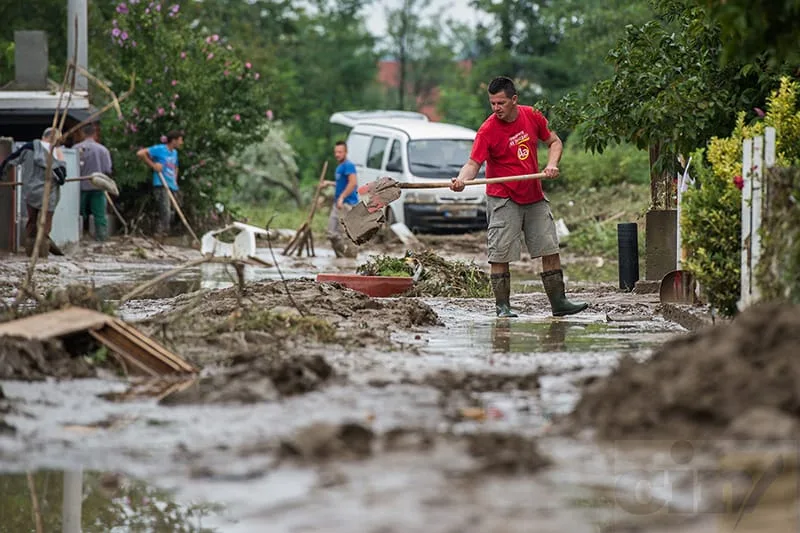The rooms smell damp and dirt on the wall testifies about the level water has reached. Furniture from the ground floor had to be thrown out or hauled up to higher floors. Sandbags are stacked before the front door and mud and dirt cake the courtyard.
This is how several houses in the Hasan Kikić Street in the Srebrenica neighborhood of Bare look in the wake of the Tinja River’s four floods in the past three months. “No one has moved back into the lower floors in our street. Luckily, most of them have attics or another floor to reside in,” local Bajazit Džafić told the Center for Investigative Reporting in Sarajevo (CIN).
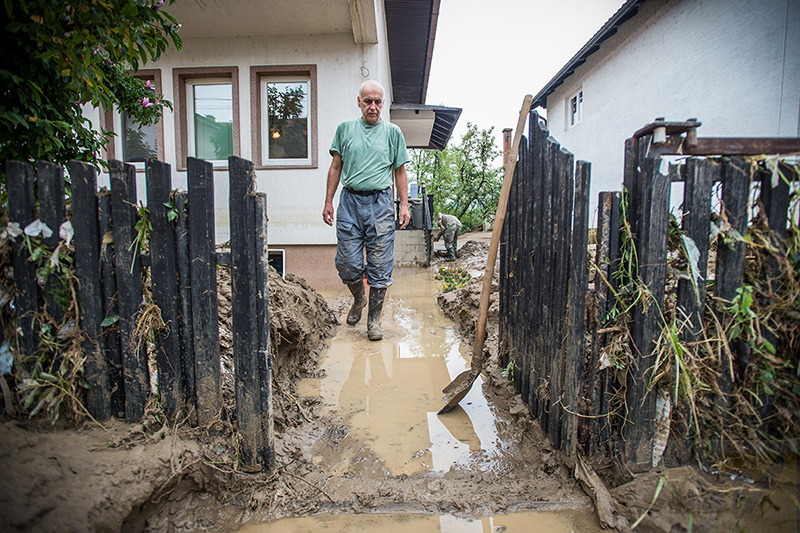
The rivers Tinja, Spreča and Jala often cause problems for Tuzla Canton (TK) residents. Even though they are normally shallow, torrential rains touch off flash floods. Some people build concrete walls or dykes near their houses for protection.
Don't want to miss our stories?
Sign up for our newsletter.
Don't want to miss our stories?
Sign up for our newsletter.
“I know we pay water taxes. I know that considerable sums are going into environmental protection…Obviously, the funds are not going where it’s meant to be going,” said Suad Helić, director of a Gračanica-based firm, RPC Superfos Balkan.
Every year, about 10 million KM worth of water taxes are collected in the canton. CIN’s investigation has shown that the revenue is not all spent on protection against rivers in the area –but on civil servants, long-service benefits, for marketing, as discretionary funds and so on.
Little Things Add up to Millions
People pay a water tax during vehicle registration while companies cough up money with their employees’ salaries. The companies pay the tax if they use water for such things as production or fisheries or if they use rivers to dispose of waste or to mine gravel.
Out of the collected tax, 15 percent goes to the Fund for Environmental Protection of the Federation of Bosnia and Herzegovina (FBiH) for ecological projects; 40 percent goes to the Agency for the Sava River Basin, and 45 percent stays with the canton for managing the waterways and water protection facilities in that jurisdiction.
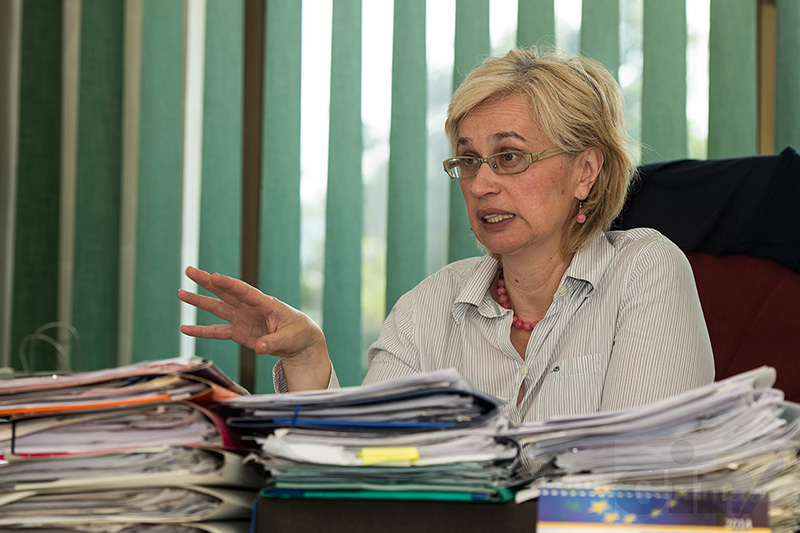
Mirela Uljić from the Tuzla Cantonal Ministry of Agriculture, Water Management and Forestry said that the canton has been left with around 4 million KM from the water environmental tax annually over the past several years. That money is intended to be spent to co-finance the construction and maintenance of water facilities used as prevention against floods, for drainage, water exploitation and pollution protection. Some money was spent on blueprint development and similar related expenses.. A relevant ministry would propose an investment program, while the cantonal government approved the spending of the funds.
Uljić said that the money at hand is earmarked for projects of importance to the canton and the municipalities. “The system turned out to be very inadequate. Suffice it to say that the planning is done at the yearly level. Every year the municipalities have different priorities,” said Uljić. It so happens, she said, that the first project has not even been wrapped up, while another one is sent in. “There is still no long-term strategic planning.”
According to the records from the Cantonal Official Gazette Srebrenik’s priorities in 2011 and in 2013 had to do with waste water treatment. Uljić said that the Canton’s priority in this area was reconstruction of the Modrac Lake’s dyke. This 50-year old dyke was built on the Spreča River so that the water could accumulate for use in industry production. Uljić said that this dyke was more or less stable and that the reconstruction is being done in phases.
According to ministry records, the reconstruction of a 150,000 KM section of the dyke had been scheduled for the previous year, but the work never got off the ground. It is not rare to see agreements signed while work is never done. At the end of 2012, the ministry did not spend 1.6 million KM of the funds, while at the end of last year it had around 650,000 KM of the contracted, but not realized obligations, said Uljić.
She said that this happens when deals are made during the construction off-season, so they end up being pushed into the following year, or when the transfer of money from the canton to the municipalities is delayed, or because the finance ministry does not have money to finance the works.

The cantonal government’s records show that the money is not always available for water protection, because the government loans the money to its agencies for salaries. This also happened in the midst of the floods in May and August. In May, the canton loaned 2.2 million KM, and in August it loaned 3.4 million KM again for the payment of salaries. A note in the records says that the money was to be paid back from revenues. However, a few days ago, the government loaned money to the agencies again to pay out August salaries.
Reports on the water taxes show that some money was also spent on river maintenance and protection, drafting bylaws and the expert and technical documentation, as well as promotional activities. For example, for the celebration of the World Water Day the Canton spent 3,000 KM and 10,000 KM for water resources awareness rising last year.
Money to Sarajevo then Back to Tuzla
In the past four years, the Agency for the Sava River Basin headquartered in Sarajevo receives around 3.5 million KM from Tuzla Canton. This is nearly one quarter of its annual revenue.
The agency manages waterways of the first category, such as the Tinja and Spreča rivers which cause problems to the Canton’s inhabitants. The agency spends an average 1 million KM a year to clean riverbeds, construct or repair dykes, and develop blueprints.
According to the Agency’s financial reports, it spent around 5.5 million KM on investments in water facilities in its jurisdiction, and another 4.4 million KM on the agency itself last year. It paid its employees vacation allowances, insurance premiums, reimbursements for living away from home, long-service benefits. Water tax money also went for professional development of employees, scholarships, promotions and court expenses.
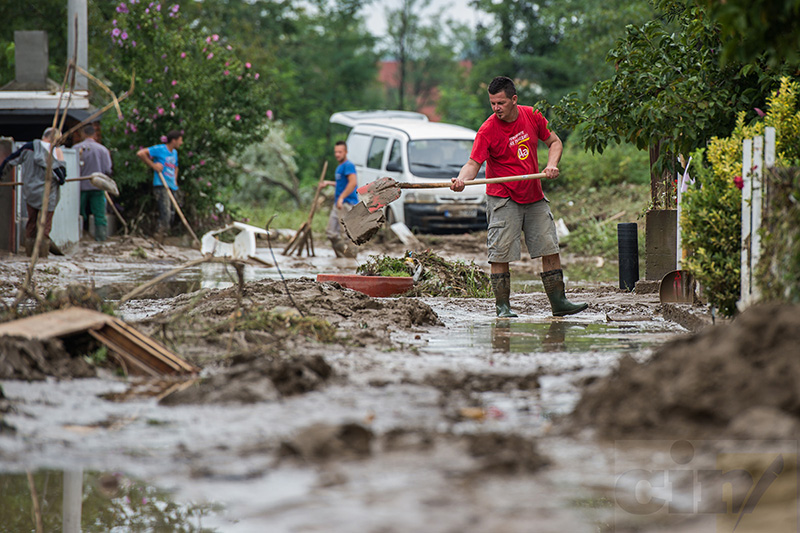
The Agency’s Director Sejad Delić said that some 2,000 kilometers of banks which need to be secured and maintained are under the agency’s jurisdiction, as are 15 waterways and five artificial lakes in eight cantons. He said that this requires a lot of money and that it does not manage to collect all that is due in water taxes. “With this manner of collecting and distributing funds we cannot secure our river beds in a significant way,” said Delić. “Without the international and donor loans we cannot operate. Or we might increase the price and scope water taxes.”
Delić said that the agency’s board is preparing criteria for the selection of projects, while taking into account if the (proposed) stretches are of critical importance, whether they threaten towns and villages, banks, roads, industry etc. The Federation Ministry of Agriculture, Water Management and Forestry will sign off on the funds. He said that both the municipalities and cantons are invited to submit project proposals.
Along with the priority projects, such as the reconstruction of the Sava dyke and the reconstruction of the pump station in Posavina, the agency is supposed to cover the costs of repairing flood-related damages to the waterworks of first category. These are estimated to around 20 million KM for this year.
Problems and Solutions
Uljić of the Tuzla Ministry of Agriculture, Water Management and Forestry said unsolved property-related legal issues along river banks that need to be cleaned and fortified must be dealt with. Sometimes agency officials are unable to determine the ownership, and at other times agree on the compensation money.
“The Jala in Lukavac is not regulated. Every year it causes horrendous damages before it flows into the Spreča. The works began and stopped because it was not possible to solve property and legal issues,” said Uljić. She added that sometimes the same amount of money is required to purchase the land as it is to pay for the works. “According to some proposed solutions it is estimated that it would cost between 50 and 60 million KM to regulate the Spreča River downstream from the confluence with Jala,” she said.
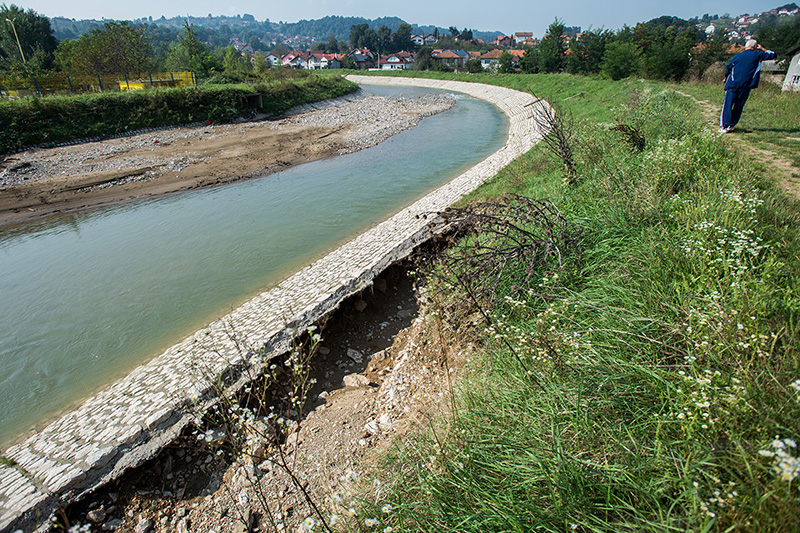
According to director Delić, another issue in water protection is divided jurisdictions over the rivers. Take the Spreča River for example. He explained the cantonal ministry in Tuzla is in charge from the source to the Modrac Lake, while downstream from the lake in the length of 18 kilometer is under the charge of the agency he heads. “Then we arrive at the municipality of Gračanica: the left bank is under the jurisdiction or the Republika Srpska (RS) authorities, that is a Bijeljina-based Water Agency and the RS Ministry of Agriculture, Water Management and Forestry, while, the Sava Basin Agency is in charge of the right bank.”
Delić said that for works to be carried out in that part of the river they need to ask for approval from the RS. “How to do something?! How will I build a dyke without the RS’s approval? We’re fed up with the Spreča River issue, because we want to repair, construct; we earmark money, make an agreement with the Bijeljina agency, make a plan and when we need to jointly implement it, they say that they don’t have money,” said Delić.
The agency’s yearly report thus states that funds intended for development of blueprints for the regulation of the Spreča River bed were transferred for other budget beneficiaries. This is why some critical stretches on the river are being worked on, such as at the site of Samarić in the Klokotnica settlement.
Helić from Gračanica whose firm was submerged by the Spreča causing around 1 million KM in damages, does not accept such excuses. He said that, for example, the Lake Modrac contains 25 percent of mud which is why the lake spills over into the Spreča.
“It there were no mud, the lake would not spill over,” said Helić.
He said that he heard from the officials that it would take around 40 million KM to clean the mud. Helić thinks that it’s better to take a loan if necessary and solve the problem, then to repair damages which just in this year amount to around 100 million KM in Tuzla Canton.
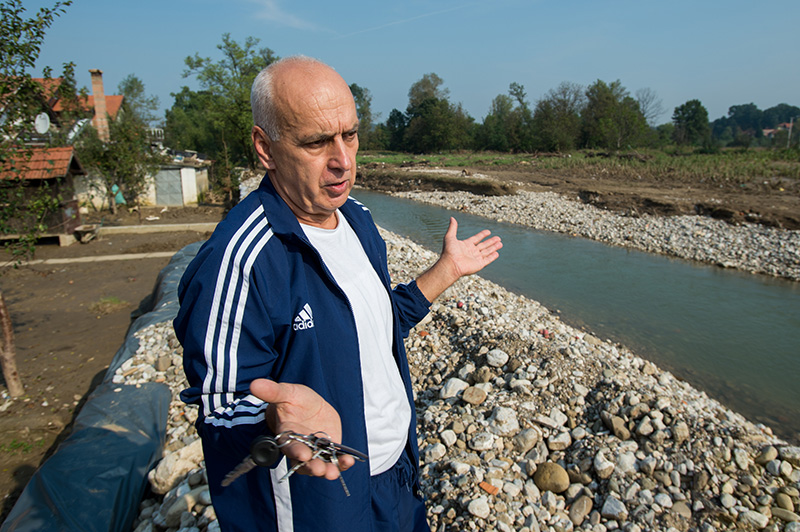
The officials from the Sava Basin Agency say that they are doing everything they can. This year they planed to invest around 330,000 KM into cleaning and fortifying of the Tinja River. “The blueprints are in progress and I think they will be done in the beginning of the next week and I think that the public procurement process will follow,” said Delić.
Srebrenik officials say that from mid-May when there was a huge flood, they widened and deepened the Tinja’s River bed and built a dyke.
A villager Džafić said that the fortified stone dyke placed under his house can protect Bare residents only from smaller floods. “If we talk about the floods that took place in August and May, then the current wall could not guard against,” said Džafić.
Even though around 300,000 KM in water taxes is collected every year from Srebrenik Municipality, Džafić and other residents had to install concrete protection walls with their own money. The residents say that they’ve been under water almost every year in the past 30.
Employees of Gračanica-based Isowood have also relied on themselves, investing around 100,000 KM to build a wall in front of the firm. But, it could not protect them from the floods. The company suffered nearly 2 million KM of damages in May and August. A co-owner Bego Ahmetašević is angry because he does not see a point in paying water taxes: “if they (the authorities) would relieve us of all obligations, I could hire 10 more people, increase salaries.”



